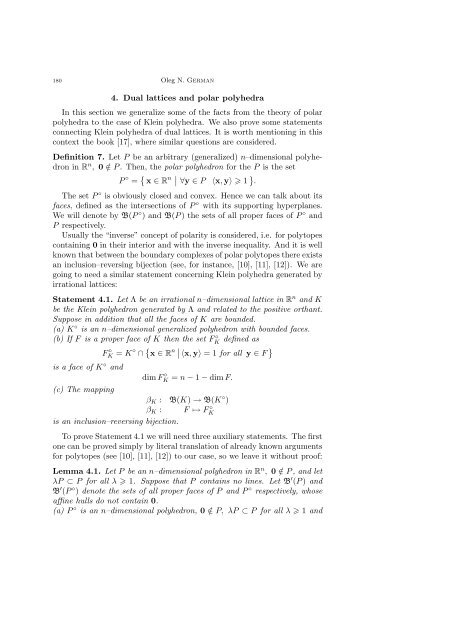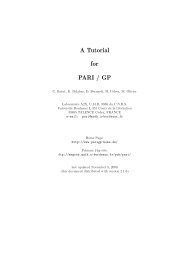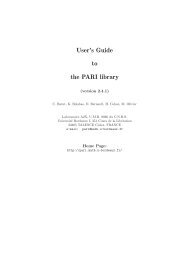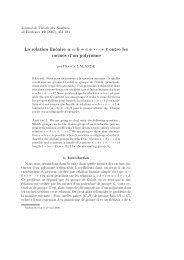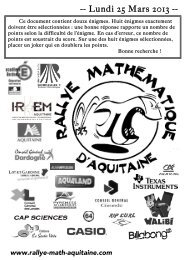multidimensional polyhedron
Klein polyhedra and lattices with positive norm minima
Klein polyhedra and lattices with positive norm minima
- No tags were found...
You also want an ePaper? Increase the reach of your titles
YUMPU automatically turns print PDFs into web optimized ePapers that Google loves.
180 Oleg N. German<br />
4. Dual lattices and polar polyhedra<br />
In this section we generalize some of the facts from the theory of polar<br />
polyhedra to the case of Klein polyhedra. We also prove some statements<br />
connecting Klein polyhedra of dual lattices. It is worth mentioning in this<br />
context the book [17], where similar questions are considered.<br />
Definition 7. Let P be an arbitrary (generalized) n–dimensional <strong>polyhedron</strong><br />
in R n , 0 /∈ P . Then, the polar <strong>polyhedron</strong> for the P is the set<br />
P ◦ = { x ∈ R n ∣ ∣ ∀y ∈ P 〈x, y〉 1 } .<br />
The set P ◦ is obviously closed and convex. Hence we can talk about its<br />
faces, defined as the intersections of P ◦ with its supporting hyperplanes.<br />
We will denote by B(P ◦ ) and B(P ) the sets of all proper faces of P ◦ and<br />
P respectively.<br />
Usually the “inverse” concept of polarity is considered, i.e. for polytopes<br />
containing 0 in their interior and with the inverse inequality. And it is well<br />
known that between the boundary complexes of polar polytopes there exists<br />
an inclusion–reversing bijection (see, for instance, [10], [11], [12]). We are<br />
going to need a similar statement concerning Klein polyhedra generated by<br />
irrational lattices:<br />
Statement 4.1. Let Λ be an irrational n–dimensional lattice in R n and K<br />
be the Klein <strong>polyhedron</strong> generated by Λ and related to the positive orthant.<br />
Suppose in addition that all the faces of K are bounded.<br />
(a) K ◦ is an n–dimensional generalized <strong>polyhedron</strong> with bounded faces.<br />
(b) If F is a proper face of K then the set FK ◦ defined as<br />
FK ◦ = K ◦ ∩ { x ∈ R n ∣ 〈x, y〉 = 1 for all y ∈ F }<br />
is a face of K ◦ and<br />
dim F ◦ K = n − 1 − dim F.<br />
(c) The mapping<br />
β K : B(K) → B(K ◦ )<br />
β K : F ↦→ FK<br />
◦<br />
is an inclusion–reversing bijection.<br />
To prove Statement 4.1 we will need three auxiliary statements. The first<br />
one can be proved simply by literal translation of already known arguments<br />
for polytopes (see [10], [11], [12]) to our case, so we leave it without proof:<br />
Lemma 4.1. Let P be an n–dimensional <strong>polyhedron</strong> in R n , 0 /∈ P , and let<br />
λP ⊂ P for all λ 1. Suppose that P contains no lines. Let B ′ (P ) and<br />
B ′ (P ◦ ) denote the sets of all proper faces of P and P ◦ respectively, whose<br />
affine hulls do not contain 0.<br />
(a) P ◦ is an n–dimensional <strong>polyhedron</strong>, 0 /∈ P, λP ⊂ P for all λ 1 and


